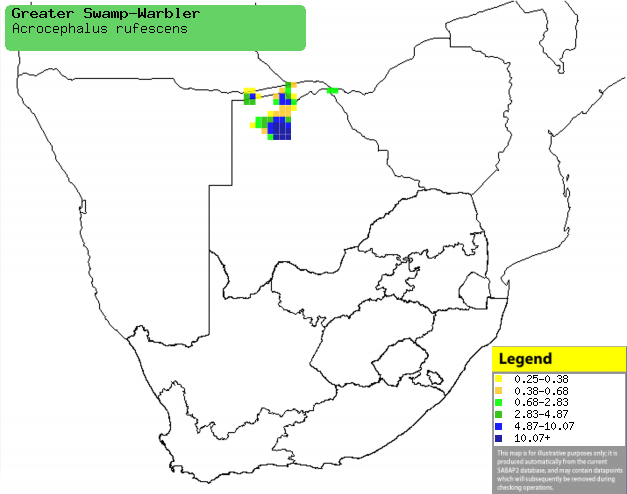|
Acrocephalus rufescens (Greater
swamp-warbler)
Rooibruinrietsanger [Afrikaans]; Papyrusrietzanger [Dutch];
Rousserolle des cannes [French]; Papyrusrohrsänger [German];
Rouxinol-grande-dos-pântanos [Portuguese]
Life
> Eukaryotes >
Opisthokonta
> Metazoa (animals) >
Bilateria >
Deuterostomia > Chordata >
Craniata > Vertebrata (vertebrates) > Gnathostomata (jawed
vertebrates) > Teleostomi (teleost fish) > Osteichthyes (bony fish) > Class:
Sarcopterygii (lobe-finned
fish) > Stegocephalia (terrestrial
vertebrates) > Tetrapoda
(four-legged vertebrates) > Reptiliomorpha > Amniota >
Reptilia (reptiles) >
Romeriida > Diapsida > Archosauromorpha > Archosauria >
Dinosauria
(dinosaurs) > Saurischia > Theropoda (bipedal predatory dinosaurs) >
Coelurosauria > Maniraptora > Aves
(birds) > Order: Passeriformes
> Family: Sylviidae > Genus: Acrocephalus
Distribution and habitat
It has populations scattered across Sub-Saharan African
swamps, with one extending from south-eastern Angola and south-western Zambia to
northern Botswana and the Caprivi Strip. Here it is locally common in patches
Papyrus (Cyperus papyrus) in swamps and along the banks of rivers.
|
 |
|
Distribution of Greater swamp-warbler in southern Africa,
based on statistical smoothing of the records from first SA Bird Atlas
Project (©
Animal Demography unit, University of
Cape Town; smoothing by Birgit Erni and Francesca Little). Colours range
from dark blue (most common) through to yellow (least common). |
Food
It gleams insects from the stems of Papyrus (Cyperus
papyrus), sometimes flying out of the reedbed to forage on lily pads, where
it occasionally catches small frogs The following food items have been recorded
in its diet:
- Insects
- beetle larvae (Coleoptera)
- moths
- noctuid moth larvae
- damsel flies
- other aquatic insects
- Small frogs
Breeding
- The nest is a deep cup built of Papyrus (Cyperus papyrus) and other
reed leaves, attached to a number of Papyrus stems, usually 1.0-2.5 m above
the water level.
- Egg-laying season is from December-February.
- It lays 2-3 eggs, which are incubated by both sexes for at least 14
days.
- The chicks are fed by both adults, leaving the nest after roughly 14
days.
Threats
Not threatened although local destruction of swamps may be
cause for concern.
References
-
Hockey PAR, Dean WRJ and Ryan PG 2005. Roberts
- Birds of southern Africa, VIIth ed. The Trustees of the John Voelcker
Bird Book Fund, Cape Town.
|
